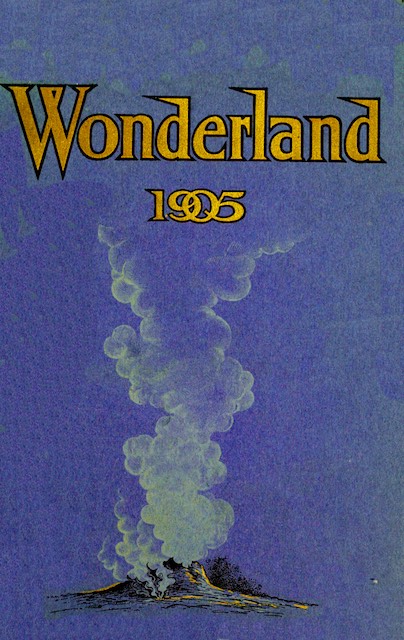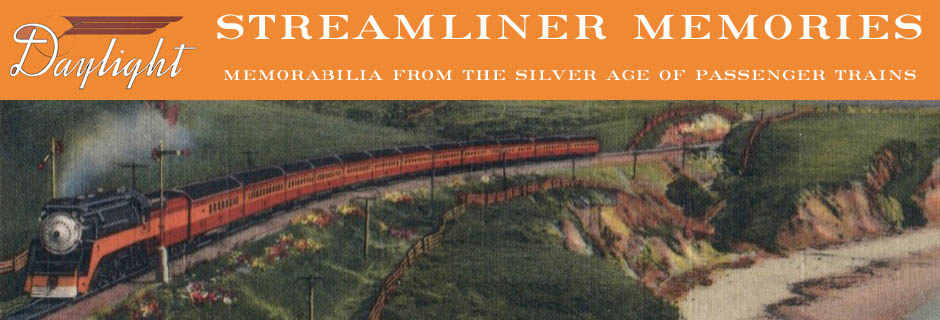Other than the gold lettering, the cover of the 1905 Wonderland booklet is more subdued than in most previous years. Inside, however, the reader is treated to an innovation: fold-out pages presenting panoramic views of Yellowstone Park and other scenes. The booklet contains four different sets of fold outs, allowing for many large photos.
 Click image to download a 37.9-MB PDF of this 118-page booklet.
Click image to download a 37.9-MB PDF of this 118-page booklet.
After I finished making a PDF of this booklet using images from archive.org, I obtained my own copy of the booklet. I based the PDF on descriptions in various libraries saying the booklet was 24 cm (9-1/2″) tall. Based on the images, I made the booklet 6.3″ wide. It turns out the booklet is actually about 6.75″ wide, but parts of the interior pages were cropped out of the images in order to avoid harming the binding. No information was lost except that the PDF is slightly narrower than reality. This is true of earlier wonderland booklets as well.
Three of the sets of fold outs pair two different folding pages together, so one side of each page allows for photos up to around 12″ wide and the other sides of the facing fold outs allow for 24″-wide photos. The fourth fold out is just one page that folds twice, allowing for a photo of Yellowstone Canyon that is more than 18″ wide.
While I greatly appreciate whoever scanned or photographed these booklets, they didn’t make much of an effort to be consistent in page lighting. Many of the booklets have all even-numbered pages one shade of tan and all the odd-numbered pages a different shade. These fold outs are even worse in that they are all a sickly green. I tried to fix that but all I could do was turn them gray. Eventually, I hope to scan my own copies of some of these booklets for more consistent results.
In addition to the fold outs, the frontispiece has a nicely colorized Haynes photo of Lower Yellowstone Falls. This is the best colorized photo used in the Wonderland series up to this year. The red and orange colors in the photo almost perfectly match the colors of Yellowstone Canyon, and are highlighted by red tints used on the facing title page of the booklet.
The booklet includes chapters on Minnesota’s new state capitol building, Lake Superior, the North Dakota Badlands, the final resting place of a Sioux Indian named Lame Deer who was killed in one of the battles after the Little Big Horn, Yellowstone, Lake Kachess in the Washington Cascades, Portland’s Lewis & Clark Exposition, and the Shasta Route to California. Other than the Yellowstone article, none of these would have been found in a pre-Wheeler Wonderland.
Having been raised in Portland, I found the article on the exposition most interesting. It included woodcuts showing an aerial view of the fairgrounds and the entrance, which was lined with streetcars bringing people to the expo, as well as actual photos of many of the buildings. While most of the buildings were built to look like they were made of marble or sandstone, the only one to survive the fair was a huge log structure called the Forestry Building. I visited that building several times before it was destroyed by a fire in 1964.
I have also lived in the Siskiyou Mountains of southwest Oregon, so I could also be interested in the article on the Shasta Route, which Wheeler called the Shasta-Northern Pacific Route. The Portland-Oakland route was owned by the Southern Pacific, of course, but NP wanted Midwesterners to know they could reach California by taking the Northern Pacific to Portland and the Shasta Route to California.
Rather than being about the Siskiyous, however, most of the article is about Northern Pacific’s part of the route. The article has more than a dozen photos of scenes from the NP route but just three photos of the Shasta Route. It also has four photos of passenger car interiors and one exterior, all of the North Coast Limited, but none of any Southern Pacific train. This article is the closest thing to outright advertising to appear in one of the Olin Wheeler Wonderlands.
